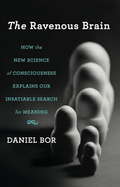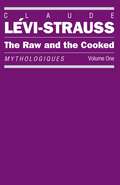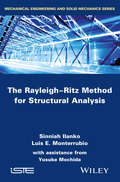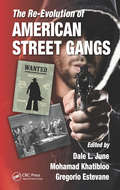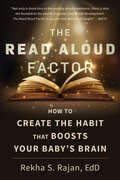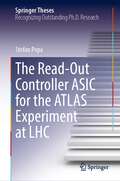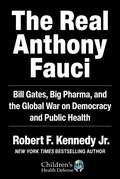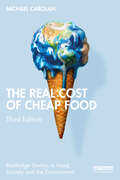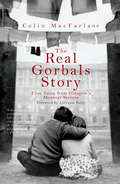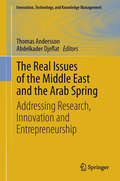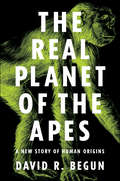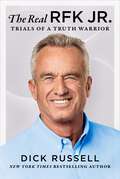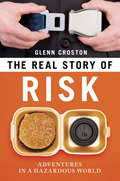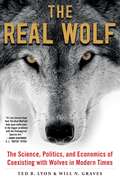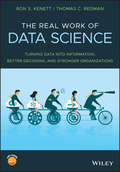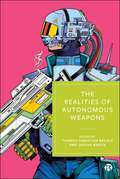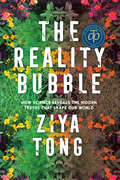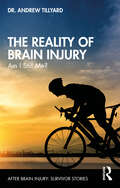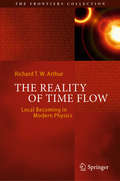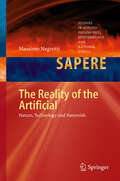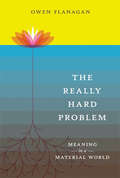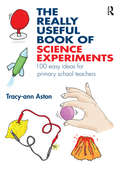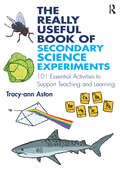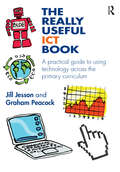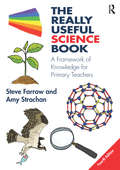- Table View
- List View
The Ravenous Brain: How the New Science of Consciousness Explains Our Insatiable Search for Meaning
by Daniel BorConsciousness is our gateway to experience: it enables us to recognize Van Gogh's starry skies, be enraptured by Beethoven's Fifth, and stand in awe of a snowcapped mountain. Yet consciousness is subjective, personal, and famously difficult to examine: philosophers have for centuries declared this mental entity so mysterious as to be impenetrable to science. In The Ravenous Brain, neuroscientist Daniel Bor departs sharply from this historical view, and builds on the latest research to propose a new model for how consciousness works. Bor argues that this brain-based faculty evolved as an accelerated knowledge gathering tool. Consciousness is effectively an idea factory--that choice mental space dedicated to innovation, a key component of which is the discovery of deep structures within the contents of our awareness. This model explains our brains' ravenous appetite for information--and in particular, its constant search for patterns. Why, for instance, after all our physical needs have been met, do we recreationally solve crossword or Sudoku puzzles? Such behavior may appear biologically wasteful, but, according to Bor, this search for structure can yield immense evolutionary benefits--it led our ancestors to discover fire and farming, pushed modern society to forge ahead in science and technology, and guides each one of us to understand and control the world around us. But the sheer innovative power of human consciousness carries with it the heavy cost of mental fragility. Bor discusses the medical implications of his theory of consciousness, and what it means for the origins and treatment of psychiatric ailments, including attention-deficit disorder, schizophrenia, manic depression, and autism. All mental illnesses, he argues, can be reformulated as disorders of consciousness--a perspective that opens up new avenues of treatment for alleviating mental suffering. A controversial view of consciousness, The Ravenous Brain links cognition to creativity in an ingenious solution to one of science's biggest mysteries.
The Raw and the Cooked: Introduction to a Science of Mythology Volume 1
by Claude Levi-Strauss John Weightman Doreen WeightmanThe book starts out making an analogy between music and myth. A piece of music is only music when it has one or more motifs which repeat and vary in structured ways. So avant-garde atonal serial music is not music. Myth works exactly the same way; recurring motifs hold a story together. The motif itself is not meaningful, as only the patterning and arrangement of motifs in the composition of the music/myth gives the work significance. The notes of a song played on an instrument do not have meaning the same way that spoken words strung together in a sentence have meaning. But these instrumental or mythic performances do have meanings and comprise ideas. Claude Levi-Strauss' work is translated by Doreen and John Weightman. It adds yet another chapter to the tireless quest for a scientifically accurate, esthetically viable, and philosophically relevant cultural anthropology.
The Rayleigh-Ritz Method for Structural Analysis
by Luis Monterrubio Sinniah Ilanko Yusuke MochidaA presentation of the theory behind the Rayleigh-Ritz (R-R) method, as well as a discussion of the choice of admissible functions and the use of penalty methods, including recent developments such as using negative inertia and bi-penalty terms. While presenting the mathematical basis of the R-R method, the authors also give simple explanations and analogies to make it easier to understand. Examples include calculation of natural frequencies and critical loads of structures and structural components, such as beams, plates, shells and solids. MATLAB codes for some common problems are also supplied.
The Re-Evolution of American Street Gangs
by Dale L. June Mohamad Khatibloo Gregorio EstevaneThe problem of gangs and gang subculture is a growing threat to the stability of neighborhoods and entire communities. During the past two decades, gang members have increasingly migrated from large urban centers to suburban areas and other countries. This book addresses the intricacies and diversities of street gangs, drawing on the expertise of h
The Read Aloud Factor: How to Create the Habit That Boosts Your Baby's Brain
by Rekha S. RajanWe have always known that reading aloud is an important way to bond with your baby and develop language skills. Now neuroscience research is showing us the long-term benefit that reading aloud has for children—all the way into adulthood. Author Rekha S. Rajan was part of current research that shows individuals who were read to more frequently as children had a measurably healthier brain in old age.This innovative and accessible book incorporates the latest research on brain development, describes how reading aloud supports language and social-emotional development, and gives parents and caretakers what they need to make read alouds a regular and enjoyable part of the family routine.
The Read-Out Controller ASIC for the ATLAS Experiment at LHC (Springer Theses)
by Stefan PopaThis thesis presents the complete chain from specifications to real-life deployment of the Read Out Controller (ROC) ASIC for the ATLAS Experiment at LHC, including the design of the FPGA-based setup used for prototype validation and mass testing of the approximately 6000 chips. Long-lasting experiments like the ATLAS at the LHC undergo regular upgrades to improve their performance over time. One of such upgrades of the ATLAS was the replacement of a fraction of muon detectors in the forward rapidities to provide much-improved reconstruction precision and discrimination from background protons. This new instrumentation (New Small Wheel) is equipped with custom-designed, radiation-hard, on-detector electronics with the Read Out Controller chip being a mission-critical element. The chip acts as a clock and control signals distributor and a concentrator, buffer, filter and real-time processor of detector data packets. The described and deployed FPGA-based test setup emulates the asynchronous chip context and employs optimizations and automatic clock and data synchronization. The chip's tolerance to nuclear radiation was evaluated by recording its operation while controlled ultrafast neutron beams were incident to its silicon die. Predictions for the operating environment are made. A proposed implementation of an FPGA Integrated Logic Analyzer that mitigates the observed limitations and constraints of the existing ones is included.
The Real Anthony Fauci: Bill Gates, Big Pharma, and the Global War on Democracy and Public Health (Children’s Health Defense)
by Robert F. Kennedy Jr.#1 on AMAZON, TWENTY WEEKS on the NEW YORK TIMES BESTSELLER LIST, and a WALL STREET JOURNAL, USA TODAY and PUBLISHERS WEEKLY NATIONAL BESTSELLEROver 1,000,000 copies sold despite censorship, boycotts from bookstores and libraries, and hit pieces against the author. Pharma-funded mainstream media has convinced millions of Americans that Dr. Anthony Fauci is a hero. Hands down, he is anything but. As director of the National Institute of Allergy and Infectious Diseases (NIAID), Dr. Anthony Fauci dispenses $6.1 billion in annual taxpayer-provided funding for rigged scientific research, allowing him to dictate the subject, content, and outcome of scientific health research across the globe—truly a dark agenda. Fauci uses the financial clout at his disposal in a back handed manner to wield extraordinary influence over hospitals, universities, journals, and thousands of influential doctors and scientists—whose careers and institutions he has the power to ruin, advance, or reward in an authoritarian manner. During more than a year of painstaking and meticulous research on his laptop and through interviews, Robert F. Kennedy Jr. unearthed a shocking story that obliterates media spin on Dr. Fauci . . . and that will alarm every American—Democrat or Republican—who cares about democracy, our Constitution, and the future of our children&’s health.The Real Anthony Fauci reveals how &“America&’s Doctor&” launched his career during the early AIDS crisis by partnering with pharmaceutical companies to sabotage safe and effective off-patent therapeutic treatments for AIDS. Fauci orchestrated fraudulent do-nothing studies, and then pressured US Food and Drug Administration (FDA) regulators into approving a deadly chemotherapy treatment he had good reason to know was worthless against AIDS. Fauci did the unthinkable and repeatedly violated federal laws to allow his Pharma partners to use impoverished and dark-skinned children as lab rats in beyond order, deadly experiments with toxic AIDS and cancer chemotherapies. In early 2000, Fauci shook hands with Bill Gates in the library of Gates&’ $147 million Seattle mansion, cementing a partnership that would aim to control an increasingly profitable $60 billion global vaccine enterprise with unlimited growth potential. Through funding leverage and carefully cultivated personal relationships with heads of state and leading media and social media institutions, the Pharma-Fauci-Gates alliance exercises dominion over global health policy and our beautiful country. This is not just another political book. The Real Anthony Fauci details how Fauci, Gates, and their cohorts use their control of media outlets—both conservative and liberal leaning, scientific journals, key government and quasi-governmental agencies, global intelligence agencies, and influential scientists and physicians to flood the public with fearful propaganda about COVID-19 virulence and pathogenesis, and to muzzle debate and ruthlessly censor dissent.
The Real Cost of Cheap Food (Routledge Studies in Food, Society and the Environment)
by Michael CarolanThis thought-provoking, accessible book critically examines the dominant food regime on its own terms, by seriously asking whether we can afford cheap food and by exploring what exactly cheap food affords us.The author shows why today's global food system produces just the opposite of what it promises. The food produced under this regime is in fact exceedingly expensive. Many of these costs will be paid for in other ways or by future generations and cheap food today may mean expensive food tomorrow. By systematically assessing these costs the book delves into issues related, but not limited to, the food system, the environment, sustainable development, health, and social justice. In this new edition the author brings all data and citations fully up to date. Increased coverage is given to many topics including climate change, vertical agriculture, global pandemics, geopolitical instability, agriculture 4.0, alternative proteins, and food justice. Detailing the numerous ways that our understanding of food has narrowed, such as its price per ounce, combination of nutrients, yield per acre, or calories, the book argues for a more contextual view of food when debating its affordability. Expanding an innovation introduced in the second edition, concrete case studies of collective mobilization can be found throughout all chapters to support a narrative that balances being critical with being hopeful.This book is essential reading for those interested in critical food studies, food and agriculture, and a sustainable and socially just food system.
The Real Gorbals Story: True Tales from Glasgow's Meanest Streets
by Colin MacFarlaneColin MacFarlane was born in the Gorbals in the 1950s, 20 years after the publication of No Mean City, the classic novel about pre-war life in what was once Glasgow's most deprived district. He lived in the same street as its fictional 'razor king', Johnnie Stark, and subsequently realised that a lot of the old characters represented in the book were still around as late as the 1960s. Men still wore bunnets and played pitch and toss; women still treated the steamie as their social club. The razor gangs were running amok once again, and filth, violence, crime, rats, poverty and drunkenness abounded, just like they did in No Mean City.MacFarlane witnessed the last days of the old Gorbals as a major regeneration programme, begun in 1961, was implemented, and, as a street boy, he had a unique insight into a once great community in rapid decline. In this engrossing book, MacFarlane reveals what it was really like to live in the old Gorbals.
The Real Issues of the Middle East and the Arab Spring
by Thomas Andersson Abdelkader DjeflatThe wave of protests and populist uprisings in the Middle East has heightened the focus on a volatile region. But the emphasis on political issues has obscured underlying issues concerning education, infrastructure, research, innovation, entrepreneurship and sustainable economic and social development. This volume, emerging in the aftermath of a conference and workshop on science and technology in the region, presents contributions from a range of experts from the Middle East, Europe, and the United States to provide fresh new insights and perspectives on the challenges and prospects for regional development in the changing global context of our time. The authors explore such topics as: the role of information and communication technologies; mindset change in support of investment in intangible assets and risk-taking; how to approach cultural issues, institutions and governance; collaborations with other regions, and; benchmarking performance while drawing lessons of relevance for the special local context. Ultimately, they offer a number of precise policy recommendations and practical insights for creating an enabling environment for capturing economic, political, and social opportunity.
The Real Planet of the Apes
by David R. BegunWas Darwin wrong when he traced our origins to Africa? The Real Planet of the Apes makes the explosive claim that it was in Europe, not Africa, where apes evolved the most important hallmarks of our human lineage--such as dexterous hands and larger brains. In this compelling and accessible book, David Begun, one of the world's leading paleoanthropologists, transports readers to an epoch in the remote past when the Earth was home to many migratory populations of ape species.Drawing on the latest astonishing discoveries in the fossil record as well as his own experiences conducting field expeditions across Europe and Asia, Begun provides a sweeping evolutionary history of great apes and humans. He tells the story of how one of the earliest members of our evolutionary group--a new kind of primate called Proconsul--evolved from lemur-like monkeys in the primeval forests of Africa. Begun vividly describes how, over the next 10 million years, these hominoids expanded into Europe and Asia and evolved climbing and hanging adaptations, longer maturation times, and larger brains, setting the stage for the emergence of humans. As the climate deteriorated in Europe around 10 million years ago, these apes either died out or migrated south, reinvading the African continent and giving rise to the lineages of the gorilla, chimpanzee, and, ultimately, the human.Presenting startling new insights about our fossil ape ancestors, The Real Planet of the Apes is a book that fundamentally alters our understanding of human origins.
The Real RFK Jr.: Trials of a Truth Warrior
by Dick RussellAn epic biography filled with drama, conflict, and surmounted challenges.The Real RFK Jr. is an intimate biographical portrait examining the controversial activist's journey from anguish and addiction to becoming the country's leading environmental champion fighting government corruption, corporate greed, and a captured media. Written by his longtime colleague Dick Russell, the biography also exposes the misconceptions and explains the rationale behind Kennedy's campaign to protect public health. Provided exclusive source material, including access to Kennedy&’s unpublished writings and personal journals, the author conducted dozens of interviews with him as well as numerous friends and associates. Russell delves into everything from Kennedy&’s sometimes death-defying river rafting adventures to his pioneering legal cases against polluters such as Smithfield Foods and Monsanto, while founding the world&’s largest water protection group. The Real RFK Jr. also examines Kennedy&’s pursuit of the truth about the assassinations of his father and uncle, the wrongful murder conviction of his cousin, and the false narratives around the COVID-19 pandemic.
The Real Story of Risk
by Glenn CrostonOffering a wealth of fascinating information about health, sex, money, safety, food, and the environment, this book illuminates an often-misunderstood but crucial aspect of daily life. We live in a world of risk. It waits for us in our refrigerator and surrounds us on the freeway. It's lurking in our arteries and sitting in our 401(k) accounts. Given that we deal with risk on a constant basis, we should be good at it; as it turns out, though, we're not. We're blind to common risks like heart disease (one in five deaths), but we shrink in fear from rare events like shark attacks (one in a million) and airplane crashes (one in twenty thousand). What accounts for our poor ability to perceive and react to the risks that really matter? Starting from an evolutionary perspective, the author traces our distorted perception of risk back to our ancestors, reminding readers that we are all the culmination of a long line of survivors who fought life-and-death threats such as attacks from wild animals, starvation, and disease. The fact that we have covered Earth with seven billion people is a testament to our skill at overcoming these risks. But our spectacular success has also produced our contemporary artificial world with new threats like climate change, chili dogs, and online gambling. Our brains, which evolved to deal with the ancient world, are ill equipped to process the new threats we face. Croston examines the many facets of our hazardous modern environment that we only dimly perceive. He explains why we let our guard down for a beautiful face, why slow-moving risks (like rising seas) are hard to stop, how a good story (though false) can be more persuasive than dry statistics (even alarming ones), what we fear even more than death, and many other intriguing quirks about our built-in incompetence to adequately handle present-day risks.
The Real Wolf: The Science, Politics, and Economics of Coexisting with Wolves in Modern Times
by Ted B Lyon Will N. GravesThe Real Wolf is an in-depth study of the impact that wolves have had on big game and livestock populations as a federally protected species. Expert authors Ted B. Lyon and Will N. Graves, sift through the myths and misinformation surrounding wolves and present the facts about wolves in modern times. Each chapter in the book is meticulously researched and written by authors, biologists, geneticists, outdoor enthusiasts, and wildlife experts who have spent years studying wolves and wolf behavior. Every section describes a unique aspect of the wolf in the United States. The Real Wolf does not call for the eradication of wolves from the United States but rather advocates a new system of species management that would allow wolves, game animals, and farmers to coexist with one another in a way that is environmentally sustainable.Contributors to this groundbreaking environmental book include:Cat Urbigkit, award-winning wildlife author and photographerDr. Valerius Geist, foremost expert of big game in North AmericaMatthew Cronin, environmental researcher and geneticistRob Arnaud, president of Montana Outfitters and Guides Association
The Real Work of Data Science: Turning data into information, better decisions, and stronger organizations
by Thomas C. Redman Ron S. KenettThe essential guide for data scientists and for leaders who must get more from their data science teams The Economist boldly claims that data are now "the world's most valuable resource." But, as Kenett and Redman so richly describe, unlocking that value requires far more than technical excellence. The Real Work of Data Science explores understanding the problems, dealing with quality issues, building trust with decision makers, putting data science teams in the right organizational spots, and helping companies become data-driven. This is the work that spells the difference between a good data scientist and a great one, between a team that makes marginal contributions and one that drives the business, between a company that gains some value from its data and one in which data truly is "the most valuable resource." "These two authors are world-class experts on analytics, data management, and data quality; they've forgotten more about these topics than most of us will ever know. Their book is pragmatic, understandable, and focused on what really counts. If you want to do data science in any capacity, you need to read it."—Thomas H. Davenport, Distinguished Professor, Babson College and Fellow, MIT Initiative on the Digital Economy "I like your book. The chapters address problems that have faced statisticians for generations, updated to reflect today's issues, such as computational Big Data."—Sir David Cox, Warden of Nuffield College and Professor of Statistics, Oxford University "Data science is critical for competitiveness, for good government, for correct decisions. But what is data science? Kenett and Redman give, by far, the best introduction to the subject I have seen anywhere. They address the critical questions of formulating the right problem, collecting the right data, doing the right analyses, making the right decisions, and measuring the actual impact of the decisions. This book should become required reading in statistics and computer science departments, business schools, analytics institutes and, most importantly, by all business managers." —A. Blanton Godfrey, Joseph D. Moore Distinguished University Professor, Wilson College of Textiles, North Carolina State University
The Realities of Autonomous Weapons
by Thomas Christian Bächle and Jascha BareisAvailable open access digitally under CC-BY-NC-ND licence. The realities of autonomous weapons are a complex blend of both existing military technologies and visions of their future capabilities. The expected ramifications are profound and always point to the interplay between fact and fiction, actual developments and creative imagination. This book explores how these realities shape and become themselves shaped by popular culture, regulatory and ethics debates, military doctrines, policies and research. It examines phenomena ranging from film and artistic interpretations to warfare scenarios and weaponized artificial intelligence. Intended for researchers (including the disciplines of political and social sciences, media, culture and technology), policy makers, educators and journalists, this is a key resource that uncovers how autonomous weapons are constructed as both a technological reality and a futuristic possibility.
The Reality Bubble: Blind Spots, Hidden Truths, and the Dangerous Illusions that Shape Our World
by Ziya TongFrom one of the world's most engaging science journalists, a groundbreaking and wonder-filled look at the hidden things that shape our lives in unexpected and sometimes dangerous ways.Our naked eyes see only a thin sliver of reality. We are blind in comparison to the X-rays that peer through skin, the mass spectrometers that detect the dead inside the living, or the high-tech surveillance systems that see with artificial intelligence.And we are blind compared to the animals that can see in infrared, or ultraviolet, or in 360-degree vision. These animals live in the same world we do, but they see something quite different when they look around.With all of the curiosity and flair that drives her broadcasting, Ziya Tong illuminates this hidden world, and takes us on a journey to examine ten of humanity's biggest blind spots.First, we are introduced to the blind spots we are all born with, to see how technology reveals an astonishing world that exists beyond our human senses. It is with these new ways of seeing that today's scientists can image everything from an atom to a black hole. In Section Two, our collective blind spots are exposed. It's not that we can't see, Tong reminds us. It's that we don't. In the 21st century, there are cameras everywhere, except where our food comes from, where our energy comes from, and where our waste goes. Being in the dark when it comes to how we survive makes it impossible to navigate our future.Lastly, the scope widens to our civilizational blind spots. Here, the blurred lens of history reveals how we inherit ways of thinking about the world that seem natural or inevitable but are in fact little more than traditions, ways of seeing the world that have come to harm it. This vitally important new book shows how science, and the curiosity that drives it, can help civilization flourish by opening our eyes to the landscape laid out before us. Fast-paced, utterly fascinating, and deeply humane, The Reality Bubble gives voice to the sense we've all had -- that there is more to the world than meets the eye.
The Reality of Brain Injury: Am I Still Me? (After Brain Injury: Survivor Stories)
by Andrew TillyardA respected medical professional, family man, and keen athlete, Andrew Tillyard had a full and active life until a vehicle crash changed it all. He sustained a serious head injury and was airlifted to the hospital where he worked, having only just survived. In this book, he recounts the raw, uncompromising struggles he faced to rebuild his life. Drawing from regular blog entries written throughout his rehabilitation, Andrew provides an authentic reflection of the lived experience at some of the key stages along the road to recovery, from pragmatic concerns about new daily difficulties to wider concerns about his new place in life. He highlights the specific challenges and support he encountered as a person with a medical background who finds themselves in a healthcare system as a patient. With frank honesty, he takes readers beyond the simple message that things can and do improve, by demonstrating that negativity, bitterness, and occasional rage are all necessary parts of the journey. However, he also describes the many little victories that helped him keep battling on, knowing there is always hope for the future. In particular, he narrates how he learnt to do things the doctors said he would never do: walking, reading, running, and ultimately writing this book. With the perspective of ten years since his injury, the book also charts a longer-term view of the ebb and flow of recovery. This is essential reading for neuropsychologists, neurologists, and other rehabilitation therapists, as well as students in medicine, nursing, allied health, and neuropsychology. This is also a compelling and compassionate story for anyone who has survived a brain injury, who feels – as Andrew did at times – that life might not be worth living anymore, as it can show that there is always hope for the future.
The Reality of Time Flow: Local Becoming in Modern Physics (The Frontiers Collection)
by Richard T. ArthurIt is commonly held that there is no place for the 'now’ in physics, and also that the passing of time is something subjective, having to do with the way reality is experienced but not with the way reality is. Indeed, the majority of modern theoretical physicists and philosophers of physics contend that the passing of time is incompatible with modern physical theory, and excluded in a fundamental description of physical reality. This book provides a forceful rebuttal of such claims. In successive chapters the author explains the historical precedents of the modern opposition to time flow, giving careful expositions of matters relevant to becoming in classical physics, the special and general theories of relativity, and quantum theory, without presupposing prior expertise in these subjects. Analysing the arguments of thinkers ranging from Aristotle, Russell, and Bergson to the proponents of quantum gravity, he contends that the passage of time, understood as a local becoming of events out of those in their past at varying rates, is not only compatible with the theories of modern physics, but implicit in them.
The Reality of the Artificial
by Massimo NegrottiThe human ambition to reproduce and improve natural objects and processes has a long history, and ranges from dreams to actual design, from Icarus's wings to modern robotics and bioengineering. This imperative seems to be linked not only to practical utility but also to our deepest psychology. Nevertheless, reproducing something natural is not an easy enterprise, and the actual replication of a natural object or process by means of some technology is impossible. In this book the author uses the term naturoid to designate any real artifact arising from our attempts to reproduce natural instances. He concentrates on activities that involve the reproduction of something existing in nature, and whose reproduction, through construction strategies which differ from natural ones, we consider to be useful, appealing or interesting. The development of naturoids may be viewed as a distinct class of technological activity, and the concept should be useful for methodological research into establishing the common rules, potentialities and constraints that characterize the human effort to reproduce natural objects. The author shows that a naturoid is always the result of a reduction of the complexity of natural objects, due to an unavoidable multiple selection strategy. Nevertheless, the reproduction process implies that naturoids take on their own new complexity, resulting in a transfiguration of the natural exemplars and their performances, and leading to a true innovation explosion. While the core performances of contemporary naturoids improve, paradoxically the more a naturoid develops the further it moves away from its natural counterpart. Therefore, naturoids will more and more affect our relationships with advanced technologies and with nature, but in ways quite beyond our predictive capabilities. The book will be of interest to design scholars and researchers of technology, cultural studies, anthropology and the sociology of science and technology.
The Really Hard Problem: Meaning in a Material World (Bradford Bks.)
by Owen FlanaganA noted philosopher proposes a naturalistic (rather than supernaturalistic) way to solve the "really hard problem": how to live in a meaningful way—how to live a life that really matters—even as a finite material being living in a material world. If consciousness is "the hard problem" in mind science—explaining how the amazing private world of consciousness emerges from neuronal activity—then "the really hard problem," writes Owen Flanagan in this provocative book, is explaining how meaning is possible in the material world. How can we make sense of the magic and mystery of life naturalistically, without an appeal to the supernatural? How do we say truthful and enchanting things about being human if we accept the fact that we are finite material beings living in a material world, or, in Flanagan's description, short-lived pieces of organized cells and tissue?Flanagan's answer is both naturalistic and enchanting. We all wish to live in a meaningful way, to live a life that really matters, to flourish, to achieve eudaimonia—to be a "happy spirit." Flanagan calls his "empirical-normative" inquiry into the nature, causes, and conditions of human flourishing eudaimonics. Eudaimonics, systematic philosophical investigation that is continuous with science, is the naturalist's response to those who say that science has robbed the world of the meaning that fantastical, wishful stories once provided.Flanagan draws on philosophy, neuroscience, evolutionary biology, and psychology, as well as on transformative mindfulness and self-cultivation practices that come from such nontheistic spiritual traditions as Buddhism, Confucianism, Aristotelianism, and Stoicism, in his quest. He gathers from these disciplines knowledge that will help us understand the nature, causes, and constituents of well-being and advance human flourishing. Eudaimonics can help us find out how to make a difference, how to contribute to the accumulation of good effects—how to live a meaningful life.
The Really Useful Book of Science Experiments: 100 easy ideas for primary school teachers (The Really Useful)
by Tracy-ann AstonThe Really Useful Book of Science Experiments contains 100 simple-to-do science experiments that can be confidently carried out by any teacher in a primary school classroom with minimal (or no!) specialist equipment needed. The experiments in this book are broken down into easily manageable sections including: It’s alive: experiments that explore our living world, including the human body, plants, ecology and disease A material world: experiments that explore the materials that make up our world and their properties, including metals, acids and alkalis, water and elements Let’s get physical: experiments that explore physics concepts and their applications in our world, including electricity, space, engineering and construction Something a bit different: experiments that explore interesting and unusual science areas, including forensic science, marine biology and volcanology. Each experiment is accompanied by a ‘subject knowledge guide’, filling you in on the key science concepts behind the experiment. There are also suggestions for how to adapt each experiment to increase or decrease the challenge. The text does not assume a scientific background, making it incredibly accessible, and links to the new National Curriculum programme of study allow easy connections to be made to relevant learning goals. This book is an essential text for any primary school teacher, training teacher or classroom assistant looking to bring the exciting world of science alive in the classroom.
The Really Useful Book of Secondary Science Experiments: 101 Essential Activities to Support Teaching and Learning (The Really Useful)
by Tracy-ann AstonHow can a potato be a battery? How quickly will a shark find you? What food should you take with you when climbing a mountain? The Really Useful Book of Secondary Science Experiments presents 101 exciting, ‘real-world’ science experiments that can be confidently carried out by any KS3 science teacher in a secondary school classroom. It offers a mix of classic experiments together with fresh ideas for investigations designed to engage students, help them see the relevance of science in their own lives and develop a passion for carrying out practical investigations. Covering biology, chemistry and physics topics, each investigation is structured as a problem-solving activity, asking engaging questions such as, ‘How can fingerprints help solve a crime?’, or ‘Can we build our own volcano?’ Background science knowledge is given for each experiment, together with learning objectives, a list of materials needed, safety and technical considerations, detailed method, ideas for data collection, advice on how to adapt the investigations for different groups of students, useful questions to ask the students and suggestions for homework. Additionally, there are ten ideas for science based projects that can be carried out over a longer period of time, utilising skills and knowledge that students will develop as they carrying out the different science investigations in the book. The Really Useful Book of Secondary Science Experiments will be an essential source of support and inspiration for all those teaching in the secondary school classroom, running science clubs and for parents looking to challenge and excite their children at home.
The Really Useful ICT Book: A practical guide to using technology across the primary curriculum (The Really Useful)
by Graham Peacock Jill JessonThe Really Useful ICT Book is a practical and easy-to-use guide to give you all the confidence you need to use ICT really effectively inside and outside the primary classroom. It makes clear how ICT can be taught as a standalone subject, and how it can be used easily and imaginatively to enhance teaching other subjects. Jam-packed with ideas and templates to save you time, this friendly handbook offers an introduction to: using ICT inside the classroom – including interactive whiteboards, computer suites, VLEs and e-safety using ICT outside the classroom – including word processors, laptops, data loggers and digital cameras when and how to use a wide range of software and hardware – from spreadsheet packages through to digital photography, e-portfolios and software simulation using ICT in all subject areas practical suggestions for using ICT in cross-curricular topics using ICT to develop teacher and pupil creativity using ICT for assessment and in your professional role. With an emphasis on developing children’s creativity and on progression from Key Stage 1 to Key Stage 2, The Really Useful ICT Book is a comprehensive compendium of advice and inspiration for all training, newly qualified and experienced teachers, as well as those in support roles in primary schools.
The Really Useful Science Book: A Framework of Knowledge for Primary Teachers (The Really Useful)
by Steve Farrow Amy StrachanOffering support to both trainee and practising teachers, the fourth edition of The Really Useful Science Book is the perfect tool for those who wish to extend their subject knowledge, enhance their teaching and create lessons which link directly to the National Curriculum. The easy-to-follow framework provides comprehensive science knowledge for Key Stages 1 and 2 and is fully updated with new material to inspire stimulating and engaging science lessons. The book is divided into three sections: Biology, Chemistry and Physics. Each section integrates key scientific ideas and facts with innovative teaching methods and activity suggestions, and user-friendly language and illustrations help to explain key scientific concepts. With links to global learning, discussion of common misconceptions, and ideas for cross-curricular opportunities, each chapter connects knowledge to practice and informs creative and inspiring teaching. The Really Useful Science Book is an invaluable reference resource for all classroom teachers who wish to develop the confidence to teach enquiry-based practical science with relevance to pupils and their global community.
